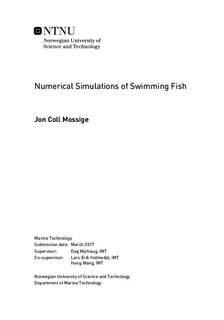Numerical Simulations of Swimming Fish
Master thesis
Permanent lenke
http://hdl.handle.net/11250/2440567Utgivelsesdato
2017Metadata
Vis full innførselSamlinger
- Institutt for marin teknikk [3472]
Sammendrag
A profound understanding of how a fish swims may be used to design innovative propulsion units with higher efficiency than the conventional screw propellers. The gain of such understanding may be aided by the use of Computational Fluid Dynamics (CFD).The swimming fish problem is characterized by deforming solids, fluid forces and the interaction between these. To capture this interaction numerically is no simple task, and inconventional fluid-structure interaction approaches, the discretized domain must be regenerated at each time step. This is called re-meshing, and it is computationally costly. The immersed boundary methods, first proposed by Peskin (1972), do not pose the need for remeshing, and are therefore good candidates for solving the swimming fish problem. This thesis presents a review of basic theory within CFD, with focus on immersed boundarymethods and fluid-structure interaction. A CFD-code, including an immersed boundary method, is developed and validated for problems involving stationary objects of arbitraryshape submerged in 2D incompressible viscous flow. The code is also designed to handlestructures with motion and deformation, but is yet to be validated for this purpose. Lastly, the further development of the code into a full 2D fluid-structure interaction solver isdiscussed with special focus on applications on swimming fish. It is concluded that such afluid-fish-solver will be severely prone to numerical instabilities, but that this can be handled by using iterative solution strategies for the calculation of the fluid force on the fish.
